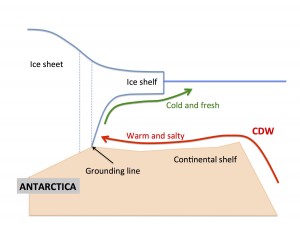From meteorological considerations, one would expect that, in a global warming world, the Antarctic Ice Sheet would grow. With higher temperatures, air parcels can hold more water. This effect would increase the amount of moisture delivered to Antarctica where it would precipitate as snow (even in a warmer world, air temperatures would remain feel below freezing).
But another side of the story is that the Antarctic ice sheet also loses mass through iceberg discharge at the continental margin, the calving process.
Fig. 1 B51 just after its birth on November 13rd, 2013. Credit to the Earth Observatory (NASA) website (http://earthobservatory.nasa.gov/NaturalHazards/view.php?id=82388) where more pictures can be found. B51 recently (April 2014) left the Amundsen bay to enter the open ocean.
One such calving event was well observed (from space) in November 2013 when iceberg B51 (a 20×30 km wide and a few hundreds of meter thick piece of ice, Figure 1) broke off from Pine Island Glacier (West Antarctica). In this case, a transverse crack in the fast ice stream was detected as early as October 2011 and the massive discharge was expected. A similar event also occurred in 2001.
It is difficult to estimate decadal changes in the ice sheet mass balance from such sporadic events. However, monitoring of the ice sheet from space now makes clear that numerous glaciers and ice streams around Antarctica have speeded up and thinned over the last decade. Overall, the West Antarctic Ice sheet is losing mass, contrarily to the meteorological expectation.
Two papers, released simultaneously on 12 May 2014, further suggest that the West Antarctic Ice Sheet may have entered a state of irreversible collapse: ice loss leads to more ice loss (Rignot et al. 2014, Jouhin et al. 2014). This instability is caused by the fact that the ice discharge of an ice stream scales with the ice thickness at the grounding line. The grounding line is that location where the ice stream is lifted off the ground and becomes afloat. Where the ground is tilted downward toward the interior of land, an instability can occur: as the grounding line moves inland, it sits under a thicker layer of ice which results in a stronger ice flow (Figure 2).
Fig. 2 Schematic of the ice sheet/ice shelf in a configuration favourable to unstable behavior. As shown by the dashed vertical lines, if the grounding line were to retreat inland, the thickness at that location would increase.
From satellite measurements (and some assumptions), Rignot et al. 2014 estimated the displacement of the grounding line of four glaciers in the Amundsen sector between 1992 and 2011. All four showed a retreat, typically a few tens of km, on depressed ground, suggesting that they had passed a threshold and their discharge would keep accelerating. Using a modeling approach, Jouhin et al. 2014 computed the future evolution of the Thwaites Glacier (one of the four above). After tuning their model so that it is consistent with observed melt rates, they found that this glacier was in fact on an unstable trajectory in most cases considered (a range of parameter sensitivity tests). In the most extreme case, the full collapse would only occur at the end of the 21st century, but large ice discharge (and associated sea level rise) would build up well before this.
So, what triggered this irreversible trend ? A change in the properties of the sea water bathing the base of the ice sheets is the most probable culprit. Although very sparse, observations of the temperature and salinity of the water masses in the Amundsen Sea are available during summertime in 1994, 2000, 2007, 2009, 2010, and 2012. The waters which move along the continental shelf are called the Circumpolar Deep water (CDW) and originate from mid-depth in the Antarctic Circumpolar Current. They are relatively warm (a couple of degrees above the freezing point). The CDW, intruding into the shelf cavity, melts the ice shelf from below, influencing its thickness and the location of the grounding line. This ultimately drives the speed of the grounded ice stream inland. Despite a large variability, it appears that the CDW on the Amundsen shelf has warmed by a few tenths of a degree since the 1990s (Jacobs et al. 2012). A small change, but enough to increase the basal melting of the ice shelf by as much as 50%, and the accelerated thinning of the Pine Island Glacier.
The reasons why the temperature (and amount) of the CDW on the shelf has increased over the last decade are unclear. Changes in the Southern Hemisphere atmospheric circulation (and in particular a positive trend of the Southern Annular mode) appear the most likely cause. These changes have been largely attributed to the Ozone Hole. It is interesting to think about possible future evolutions as the Ozone Hole recovers, the associated atmospheric changes vanish and the CDW properties are restored to their 1990s values. Could this be enough to slow down or stop the ice sheet retreat? The above studies suggest it is too late.


